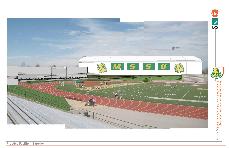Going up: Indoor practice field, weather shelter swells; along with price tag

Going up: Indoor practice field, weather shelter swells; along with price tag
$2 million will dig the base, but it won’t build the house.
What started as a state funded $2 million weather shelter that would double as an indoor practice facility has now ballooned into a full scale, 100-yard practice field with an approximate $7,101,885 price tag to match.
When it’s completed the structure, built on the north side of Fred G. Hughes Stadium, will be large enough to be used by all of Missouri Southern’s athletic teams, including football and soccer, and will include bathrooms, storage space, batting cages and an onsite coaches office.
“It’s big.” said Bob Harrington, director of the physical plant. “It seemed like if we were going to build it we should accommodate everyone.”
The project has been broken down into five phases. Phase one, awarded to low bidder DeWitt & Associates, Inc. out of Springfield, includes the digging of a retention pond, the addition of piping to deal with runoff and the building of additional parking at a total cost of approximately $1.5 million. The remaining phases will be put off until funding is available.
“The whole project is going to be pretty substantial,” said Rob Yust, assistant vice president for business affairs. “We received funding from the state for the first phase of [the project] and we had indications from the senator that secured this for us, that it needed to be spent as soon as possible.”
While, Sen. Gary Nodler (R-Joplin) who arranged the appropriation of the $2 million, agrees he wants to see construction beginning soon, he believes the funding should be spent on the establishment of something to protect athletes, coaches and fans from rain and lightening.
“The funds were not intended for earthwork, they were intended for the construction of a weather shelter,” Nodler said. “They need to be used for their intended purpose.”
Nodler also said he had little opinion on what kind of shelter Southern built, as long as it served its intended purpose.
Phase one, is slated to begin at the end of October or in very early November. The retention pond, positioned behind the site for the new practice facility, will be approximately the same size as a football field and 10-11 feet at the deepest end. The pond will hold water that currently collects on the cross country course and would be a source of problems once the practice facility was built.
“We found a lot more issues than we’d hoped for with the site,” Yust said.
While possible locations for the field have included both the north and south sides of the stadium, Yust said both presented problems with both the sewer system and utilities that came with heavy but relatively equal costs. Building on the north end of Hughes allows the future practice field to later be connected to an athletic support facility outlined in the University’s stadium “master plan.”
Donation
Since the idea of the practice field / weather shelter emerged, comments about seeking donations have been prevalent.
Harrington, Yust, former director of athletics Sallie Beard and current director of athletics Jared Bruggeman have all mentioned the need for several million dollars in donations for the completion of the now $7 million plus project.
While no potential donors have been made public and no official announcement has been made concerning commitments for the facility, elevation renderings of what the facility could look like have been drawn up displaying the logos of potential donors, among them, Downstream Casino.
Sean Harrison, spokesman for Downstream said the possibility of donating was “premature” but that Downstream could be involved in fundraising for the practice field.
“We have talked about trying to help raise some money for that facility” Harrison said. “We’re excited to help MSSU in any way.”
Bruggeman said they are hoping to cultivate relationships and the practice facility is more of a long term project.
“Ultimately if we can get the project off the ground it’s going to be a great facility that will benefit everyone,” he said. “I think there’s a missconception that athletics is on it’s own and it’s not, it’s an integral part of the school.”
Yust said the administration hopes the show of progress in the facilities groundbreaking will “steamroll ahead” and encourage others to donate.
Phases 2-5
While phase one has been set in motion, phases two through five will wait for funding by donation, though Harrington wishes the entire building could be done on one step.
“If the money was available, it makes more sense to do it all at once,” he said.
Phase two includes the footings for the building and the actual structure itself. Phase three will add plumbing, electrical and mechanical components to the building. Phase four includes flooring, drywall, paint and other cosmetic touches with phase five being the addition of any athletic equipment, including turf for the field, that is needed.
“Obviously phase two of [the project] is the biggest phase, because we’ll have the building to show for it,” Yust said.
After phase two the building will serve as a weather shelter, but it won’t function as a practice field until all five phases have been completed.
“I’d love to see it done sooner,” said Yust. “But the sooner you want it the longer it’s going take.”
Your donation will support the student journalists of Missouri Southern State University. Your contribution will allow us to purchase equipment and cover our annual website hosting costs.















